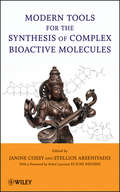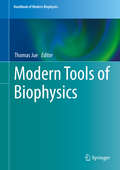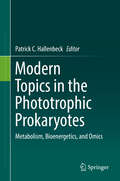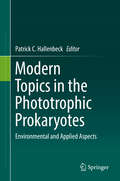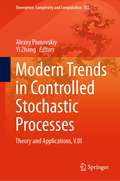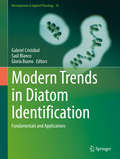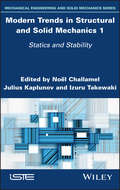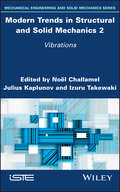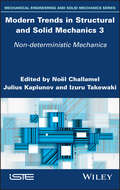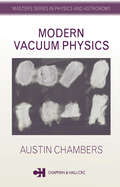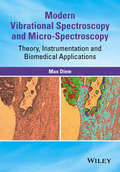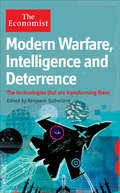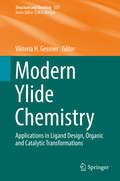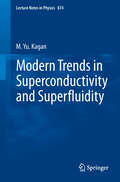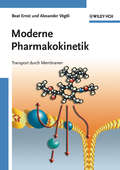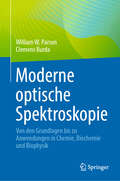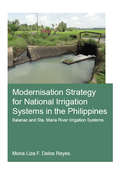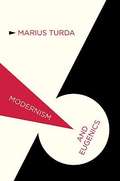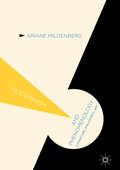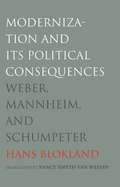- Table View
- List View
Modern Tools for the Synthesis of Complex Bioactive Molecules
by Stellios Arseniyadis Janine CossyAll the latest tools needed to plan and perform the synthesis of complex bioactive moleculesFocusing on organic, organometallic, and bio-oriented processes, this book explores the impact and use of the latest synthetic tools for the synthesis of complex biologically active compounds. Readers will discover step by step how these synthetic tools have provided new, elegant solutions to many synthetic puzzles. Moreover, they will discover innovative methods that make it possible to control the exact connectivity of atoms within a molecule in order to set precise three-dimensional arrangements.Modern Tools for the Synthesis of Complex Bioactive Molecules features sixteen chapters, each one written by one or more leading experts in organic synthesis from around the world. It covers a broad range of topics that enable readers to take advantage of the latest methods for synthesizing complex molecules, including:Modern catalysis, emphasizing key transformations such as C-H functionalizations, cross-couplings, gold-catalyzed reactions, metathesis-based syntheses, and asymmetric organocatalysisEco-compatible transformations, including rearrangements and domino reactionsTools for the synthesis of carbohydrates and alkaloidsNew techniques, including the use of fluorous tags and engineered biosynthesisThe last two chapters explore target- and diversity-oriented organic synthesis as well as the use of DNA-based asymmetric catalysis, which are all promising tools for the successful synthesis of complex bioactive molecules.Modern Tools for the Synthesis of Complex Bioactive Molecules is ideal for students and researchers who need to plan and perform the synthesis of complex molecules as efficiently as possible. The book's expert advice will help these readers quickly resolve a broad range of problems that can arise in organic syntheses.
Modern Tools of Biophysics
by Thomas JueHandbook of Modern Biophysics brings current biophysics topics into focus, so that biology, medical, engineering, mathematics, and physical-science students or researchers can learn fun#65533;damental concepts and the application of new techniques in addressing biomedical challenges. Chapters will develop the conceptual framework of the physics formalism and illustrate the biomedical applica#65533;tions. With the addition of problem sets, guides to further study, and references, the interested reader can continue to independently explore the ideas presented. Volume 5: Modern Tools of Biophysics Editor: Thomas Jue, PhD In Modern Tools of Biophysics, a group of prominent professors have provided insights into the tools used in biophysics with respect to the following topics: Wave Theory of Image Formation in a Microscope: Basic Theory and Experiments Computer Simulations and Nonlinear Dynamics of Cardiac Action Potentials Myoglobin and Hemoglobin Contribution to the NIRS Signal in Muscle Anomalous Low Angle X-Ray Scattering of Membrane with Lanthanides Recording of Ionic Currents under Physiological Conditions--Action Potential-Clamping and "Onion-Peeling" Techniques Patch Clamp Technique and Applications About the Editor Thomas Jue is a Professor in the Department of Biochemistry and Molecular Medicine at the University of California, Davis. He is an internationally recognized expert in developing and applying magnetic resonance techniques to study animal as well as human physiology in vivo and has published extensively in the field of magnetic resonance spectroscopy and imaging, near-infrared spectroscopy, bioenergetics, cardiovascular regulation, exercise, and marine biology. He served as a Chair of the Biophysics Graduate Group Program at UC Davis, where he started to develop scholarly approaches to educate graduate students with a balance of physical-science/mathematics formalism and biomedical perspective in order to promote interest at the interface of physical science, engineering, mathematics, biology, and medicine. He continues to develop the biophysics curriculum, and the Handbook of Modern Biophysics represents an aspect of that effort.
Modern Topics in the Phototrophic Prokaryotes
by Patrick C. HallenbeckThis book offers authoritative contributions by world experts actively working on different aspects of phototrophic prokaryotes. Providing up-to-date information in this rapidly advancing field, it covers the range of topics that are currently the focus of research with this group of organisms. As essentially single-celled organisms, phototrophic prokaryotes process many environmental signals and use this information to optimize their metabolism, growth rate, DNA replication and cell division. Phototrophic prokaryotes are collectively of great interest for a number of different fundamental and applied perspectives and have long served as models for understanding such basic fundamental biological processes as photosynthesis and respiration. On an ecological/environmental level they are extremely important, being the most abundant photosynthetic organisms on earth and responsible for the majority of the primary productivity in the oceans. They also hold great promise as biotechnological catalysts, being able to couple solar energy conversion through photosynthesis and carbon fixation to the production of biofuels, commodity chemicals and neutraceuticals. The book is recommended to advanced students and scientists dealing with life sciences, especially in genetics, microbiology and molecular biology.
Modern Topics in the Phototrophic Prokaryotes
by Patrick C. HallenbeckThis book offers authoritative contributions by world experts actively working on different aspects of phototrophic prokaryotes. Providing up-to-date information in this rapidly advancing field, it covers the range of topics that are currently the focus of research with this group of organisms. As essentially single-celled organisms, phototrophic prokaryotes process many environmental signals and use this information to optimize their metabolism, growth rate, DNA replication and cell division. Phototrophic prokaryotes are collectively of great interest for a number of different fundamental and applied perspectives and have long served as models for understanding such basic fundamental biological processes as photosynthesis and respiration. On an ecological/environmental level they are extremely important, being the most abundant photosynthetic organisms on earth and responsible for the majority of the primary productivity in the oceans. They also hold great promise as biotechnological catalysts, being able to couple solar energy conversion through photosynthesis and carbon fixation to the production of biofuels, commodity chemicals and neutraceuticals. The book is recommended to advanced students and scientists dealing with life sciences, especially in genetics, microbiology and molecular biology.
Modern Trends in Controlled Stochastic Processes: Theory and Applications, V.III (Emergence, Complexity and Computation #41)
by Yi Zhang Alexey PiunovskiyThis book presents state-of-the-art solution methods and applications of stochastic optimal control. It is a collection of extended papers discussed at the traditional Liverpool workshop on controlled stochastic processes with participants from both the east and the west. New problems are formulated, and progresses of ongoing research are reported. Topics covered in this book include theoretical results and numerical methods for Markov and semi-Markov decision processes, optimal stopping of Markov processes, stochastic games, problems with partial information, optimal filtering, robust control, Q-learning, and self-organizing algorithms. Real-life case studies and applications, e.g., queueing systems, forest management, control of water resources, marketing science, and healthcare, are presented. Scientific researchers and postgraduate students interested in stochastic optimal control,- as well as practitioners will find this book appealing and a valuable reference.
Modern Trends in Diatom Identification: Fundamentals and Applications (Developments in Applied Phycology #10)
by Gabriel Cristóbal Saúl Blanco Gloria BuenoHigh-resolution images of phytoplankton cells such as diatoms or desmids, which are useful for monitoring water quality, can now be provided by digital microscopes, facilitating the automated analysis and identification of specimens. Conventional approaches are based on optical microscopy; however, manual image analysis is impractical due to the huge diversity of this group of microalgae and its great morphological plasticity. As such, there is a need for automated recognition techniques for diagnostic tools (e.g. environmental monitoring networks, early warning systems) to improve the management of water resources and decision-making processes. Describing the entire workflow of a bioindicator system, from capture, analysis and identification to the determination of quality indices, this book provides insights into the current state-of-the-art in automatic identification systems in microscopy.
Modern Trends in Structural and Solid Mechanics 1: Statics and Stability
by Izuru Takewaki Noël Challamel Julius KaplunovThis book - comprised of three separate volumes - presents the recent developments and research discoveries in structural and solid mechanics; it is dedicated to Professor Isaac Elishakoff. This first volume is devoted to the statics and stability of solid and structural members. Modern Trends in Structural and Solid Mechanics 1 has broad scope, covering topics such as: buckling of discrete systems (elastic chains, lattices with short and long range interactions, and discrete arches), buckling of continuous structural elements including beams, arches and plates, static investigation of composite plates, exact solutions of plate problems, elastic and inelastic buckling, dynamic buckling under impulsive loading, buckling and post-buckling investigations, buckling of conservative and non-conservative systems and buckling of micro and macro-systems. This book is intended for graduate students and researchers in the field of theoretical and applied mechanics.
Modern Trends in Structural and Solid Mechanics 2: Vibrations
by Izuru Takewaki Noël Challamel Julius KaplunovThis book – comprised of three separate volumes – presents the recent developments and research discoveries in structural and solid mechanics; it is dedicated to Professor Isaac Elishakoff. This second volume is devoted to the vibrations of solid and structural members. Modern Trends in Structural and Solid Mechanics 2 has broad scope, covering topics such as: exact and approximate vibration solutions of rods, beams, membranes, plates and three-dimensional elasticity problems, Bolotin's dynamic edge effect, the principles of plate theories in dynamics, nano- and microbeams, nonlinear dynamics of shear extensible beams, the vibration and aeroelastic stability behavior of cellular beams, the dynamic response of elastoplastic softening oscillators, the complex dynamics of hysteretic oscillators, bridging waves, and the three-dimensional propagation of waves. This book is intended for graduate students and researchers in the field of theoretical and applied mechanics.
Modern Trends in Structural and Solid Mechanics 3: Non-deterministic Mechanics
by Izuru Takewaki Noël Challamel Julius KaplunovThis book – comprised of three separate volumes – presents the recent developments and research discoveries in structural and solid mechanics; it is dedicated to Professor Isaac Elishakoff. This third volume is devoted to non-deterministic mechanics. Modern Trends in Structural and Solid Mechanics 3 has broad scope, covering topics such: design optimization under uncertainty, interval field approaches, convex analysis, quantum inspired topology optimization and stochastic dynamics. The book is illustrated by many applications in the field of aerospace engineering, mechanical engineering, civil engineering, biomedical engineering and automotive engineering. This book is intended for graduate students and researchers in the field of theoretical and applied mechanics.
Modern Vacuum Physics
by Austin ChambersModern Vacuum Physics presents the principles and practices of vacuum science and technology along with a number of applications in research and industrial production. The first half of the book builds a foundation in gases and vapors under rarefied conditions, The second half presents examples of the analysis of representative systems and describe
Modern Vibrational Spectroscopy & Micro-Spectroscopy
by Max Diemtivity, time resolved spectroscopy and computational methods. Thus, Part 1 represents a short course into modern vibrational spectroscopy.Part II is devoted in its entirety to applications of vibrational spectroscopic techniques to biophysical and bio-structural research, and the more recent extension of vibrational spectroscopy to microscopic data acquisition. Vibrational microscopy (or microspectroscopy) has opened entirely new avenues toward applications in the biomedical sciences, and has created new research fields collectively referred to as Spectral Cytopathology (SCP) and Spectral Histopathology (SHP). In order to fully exploit the information contained in the micro-spectral datasets, methods of multivariate analysis need to be employed. These methods, along with representative results of both SCP and SHP are presented and discussed in detail in Part II.
Modern Warfare, Intelligence and Deterrence: The technologies that are transforming them (Economist Books)
by Benjamin SutherlandThe Panzerfaust-3, a German shoulder-fired heat-seeking antitank missile, can punch through a metre of solid steel-far more than any armoured vehicle could carry. The MPR-500, an Israeli precision bomb, can hammer through several storeys of a building and explode on a chosen floor. These and myriad other military and intelligences technologies are changing the world. This Economist book describes these emerging technologies and places them in the larger context of today's politics, diplomacy, business and social issues. It shows how efforts to win wars or keep the peace are driving enormous and multifold technological advances. Broadly speaking, defence technologies will continue to provide enormous advantages to advanced, Western armed forces. The book is organised into five parts: land and sea, air and space, the computer factor, intelligence and spycraft, and the road ahead, which examines the coming challenges for western armies, such as new wars against insurgents operating out of civilian areas. Comprising a selection of the best writing on the subject from the Economist, each part has an introduction linking the technological developments to political, diplomatic, business and other civilian matters. For anyone who wants to know just how smart the global war, defence and intelligence machine is, this will be revealing and fascinating reading.
Modern Ylide Chemistry: Applications In Ligand Design, Organic And Catalytic Transformations (Structure And Bonding Ser. #177)
by Viktoria H. GessnerThis volume covers recent advances in the chemistry of ylidic compounds with focus on their application in the design of ligands with unique donor properties, the development of novel organic transformations as well as the use of ylides in homogenous catalysis. Thereby, this volume particularly aims at the community of organic and organometallic chemists engaged in synthetic chemistry and catalysis as well as in the use of special ligands for the stabilization of unusual main group element species and the “transition-metal free” activation of element-element/hydrogen bonds. These fields of research are highly active and vivid research areas to which ylide chemistry has only recently started to contribute, but has already led to fascinating developments in most different directions. This volume highlights these recent developments, thus giving not only an overview over the past achievements, but also possibilities for future applications. To this end, the chapters selected in this volume combine different aspects of ylide chemistry, starting with theoretical aspects in ligand design followed by synthetic organic methods, catalytic transformations and complex chemistry.
Modern trends in Superconductivity and Superfluidity
by M. Yu. KaganThis book concisely presents the latest trends in the physics of superconductivity and superfluidity and magnetism in novel systems, as well as the problem of BCS-BEC crossover in ultracold quantum gases and high-Tc superconductors. It further illuminates the intensive exchange of ideas between these closely related fields of condensed matter physics over the last 30 years of their dynamic development. The content is based on the author's original findings obtained at the Kapitza Institute, as well as advanced lecture courses he held at the Moscow Engineering Physical Institute, Amsterdam University, Loughborough University and LPTMS Orsay between 1994 and 2011. In addition to the findings of his group, the author discusses the most recent concepts in these fields, obtained both in Russia and in the West. The book consists of 16 chapters which are divided into four parts. The first part describes recent developments in superfluid hydrodynamics of quantum fluids and solids, including the fashionable subject of possible supersolidity in quantum crystals of 4He, while the second describes BCS-BEC crossover in quantum Fermi-Bose gases and mixtures, as well as in the underdoped states of cuprates. The third part is devoted to non-phonon mechanisms of superconductivity in unconventional (anomalous) superconductors, including some important aspects of the theory of high-Tc superconductivity. |The last part considers the anomalous normal state of novel superconductive materials and materials with colossal magnetoresistance (CMR). The book offers a valuable guide for senior-level undergraduate students and graduate students, postdoctoral and other researchers specializing in solid-state and low-temperature physics.
Moderne Abwassertechnik: Erhebung, Modellabsicherung, Scale-Up, Planung
by Alexandru Braha Ghiocel GrozaDieses Buch vermittelt wichtiges Fachwissen der Okobiotechnologie fur die Vermeidung von Fehlplanung und unnotigen Folgekosten beim Bau und Betrieb von Klar- und Abwasserbehandlungsanlagen. Fur Verfahrenstechniker immer wichtiger werdende Modellrechnungen und Simulationsmethoden fur die Abwasserreinigung werden hier didaktisch aufgearbeitet und prasentiert. Die Autoren schlagen eine Brucke zwischen den biologisch-chemischen und verfahrenstechnischen Seiten der modernen Abwasserbehandlung, so dass sowohl Chemiker, Biotechnologen und Biologen als auch Ingenieure, Verfahrenstechniker und Anlagenplaner jeweils das Fachfremde im Gesamtzusammenhang erlautert finden.
Moderne Pharmakokinetik: Transport durch Membranen
by Beat Ernst Alexander VögtliWie werden Arzneimittel im Korper verteilt? Wie gelangen sie an den Wirkort und docken an die richtigen Bindungsstellen an? Wie werden sie im Korper metabolisiert und schlie?lich wieder ausgeschieden? Welches sind die Mechanismen, die diesen Transportprozessen zu Grunde liegen? All dies sind essentielle Fragen der Pharmakokinetik, eines der wichtigsten Gebiete der Arzneimittelforschung und -entwicklung. In didaktisch geschickter Form beantwortet das vorliegende Lehrbuch diese Fragen, und besticht zusatzlich durch sein ansprechendes Layout mit durchgehend vierfarbigen Abbildungen. Nicht nur ein Muss fur alle fortgeschrittenen Studenten der Pharmazie, Medizinalchemie, Chemie, Pharmakologie und angrenzender Disziplinen, sondern auch ein wertvoller Begleiter fur Dozenten und Mitarbeiter der pharmazeutischen Industrie. Aus dem Inhalt: * Der Weg des Wirkstoffs zum molekularen Target * Gastrointestinale Absorption * Prozesse an der Leber * Eliminierung an der Niere * Verteilung ins Gehirn: die Blut-Hirn-Schranke * Verteilung zur Plazenta
Moderne mathematische Methoden der Physik
by Karl-Heinz Goldhorn Hans-Peter Heinz Margarita KrausDer Vorzug des Buchs liegt in der strengen Konzentration auf das Wesentliche. Dabei deckt der Stoff ein breites Spektrum mathematischer Konzepte und Methoden ab und ist so angeordnet, dass er den Bedürfnissen der Studierenden folgt. Neben mathematischen Beweisen, die Studierende mit mathematischer Denkweise konfrontieren, bietet das Lehrbuch Aufgaben, von denen ein Großteil dem Einüben von Rechentechniken dient. Theoretische Aufgaben helfen, Begriffe zu klären und logisches Argumentieren zu üben. Das Glossar enthält alle Definitionen und Sätze.
Moderne optische Spektroskopie: Von den Grundlagen bis zu Anwendungen in Chemie, Biochemie und Biophysik
by William W. Parson Clemens BurdaDie 3. Auflage dieses Lehrbuchs bietet klare Erklärungen zu optischen spektroskopischen Phänomenen und zeigt, wie spektroskopische Techniken in der modernen Chemie, Biochemie und Biophysik eingesetzt werden.Behandelte Themen sind unter anderem:· Elektronische und vibrationelle Absorption· Fluoreszenz· Symmetrieoperationen und Berechnungen der Normalmoden· Elektronentransfer von angeregten Molekülen· Energieübertragung· Exziton-Wechselwirkungen· Elektronische und vibrationelle zirkulare Dichroismus· Kohärenz und Dephasierung· Ultraschnelle Pump-Probe- und Photon-Echo-Spektroskopie· Spektroskopie von Einzelmolekülen und Fluoreszenz-Korrelation· Raman-Streuung· Multiphotonen-Absorption· Quantenoptik und nichtlineare Optik· Entropieveränderungen während der Photoanregung· Elektronische und vibrationelle Stark-Effekte· Studien schneller Prozesse in Einzelmolekülen· Zweidimensionale elektronische und vibrationelle Spektroskopie Diese überarbeitete und aktualisierte Ausgabe bietet erweiterte Diskussionen zu Laserspektroskopie, Kristallsymmetrie, Doppelbrechung, nichtlinearer Optik, Solarzellen und Leuchtdioden. Die Erklärungen sind ausreichend gründlich und detailliert, um für Forscher, Doktoranden und fortgeschrittene Studenten in Chemie, Biochemie und Biophysik nützlich zu sein. Sie basieren auf der zeitabhängigen Quantenmechanik, werden jedoch von Grund auf entwickelt, sodass sie von Lesern mit wenig Vorwissen auf dem Gebiet verstanden werden können. Zusätzliche Themen und Highlights werden in speziellen Boxen im Text präsentiert. Das Buch ist reichhaltig mit farbigen Abbildungen illustriert. Jedes Kapitel endet mit einem Abschnitt mit Fragen zur Selbstüberprüfung.
Modernisation Strategy for National Irrigation Systems in the Philippines: Balanac and Sta. Maria River Irrigation Systems (IHE Delft PhD Thesis Series)
by Mona Liza Delos ReyesThe book presents documentary evidence of the insufficiency of rehabilitation works to close the gap between the irrigation service and actual area irrigated of publicly funded national irrigation systems in the Philippines. It outlines a methodology for formulating a modernisation plan for national irrigation systems with focus on the mostly ungauged, medium to small canal irrigation systems. The proposed methodology adaptively modified some known modernisation concepts and techniques and integrated them in a more holistic framework in the context of changing weather patterns and river flow regimes. It includes in-depth review of rehabilitation works; system diagnosis; revalidation of design assumptions on percolation and water supply; characterisation of system management, irrigation service and demand; and drawing up of options and a vision for the modernised irrigation systems. Central to the proposed modernisation strategy is the logical coherence among the design of physical structures, system operation and water supply so that improvements of irrigation service are possible. The book discusses the development of the proposed methodology and demonstrates its utility in two case study irrigation systems.
Modernism and Eugenics
by Marius TurdaModernism and Eugenics comprehensively explores modern Europe's fixation with eugenic programmes of racial and national purification. It convincingly demonstrates that between 1870 and 1940 eugenicists were not only preoccupied with rescuing the individual from the anomie of modernity but equally championed a glorious racial destiny for the nation.
Modernism and Phenomenology: Literature, Philosophy, Art (Modernism and... #10)
by Ariane MildenbergBraiding together strands of literary, phenomenological and art historical reflection, Modernism and Phenomenology explores the ways in which modernist writers and artists return us to wonder before the world. Taking such wonder as the motive for phenomenology itself, and challenging extant views of modernism that uphold a mind-world opposition rooted in Cartesian thought, the book considers the work of modernists who, far from presenting perfect, finished models for life and the self, embrace raw and semi-chaotic experience. Close readings of works by Paul Cézanne, Gertrude Stein, Franz Kafka, Gerard Manley Hopkins, Wallace Stevens, Paul Klee, and Virginia Woolf explore how modernist texts and artworks display a deep-rooted openness to the world that turns us into "perpetual beginners." Pushing back against ideas of modernism as fragmentation or groundlessness, Mildenberg argues that this openness is less a sign of powerlessness and deferred meaning than of the very provisionality of experience.
Modernism's Inhuman Worlds
by Rasheed TazudeenModernism's Inhuman Worlds explores the centrality of ecological precarity, species indeterminacy, planetary change, and the specter of extinction to modernist and contemporary metamodernist literatures. Modernist ecologies, Rasheed Tazudeen argues, emerge in response to the enigma of how to imagine inhuman being—including soils, forests, oceans, and the earth itself—through languages and epistemologies that have only ever been humanist. How might (meta)modernist aesthetics help us to imagine (with) inhuman worlds, including the worlds still to be made on the other side of mass extinction? Through innovative readings of canonical and emergent modernist and metamodernist works, Tazudeen theorizes inhuman modernism as a call toward further receptivity to the worlds, beings, and relations that tend to go unthought within Western humanist epistemologies. Modernist engagements with the figures of enigma, riddle, and metaphor, according to the book's central argument, offer a means toward what Franz Kafka calls an "otherwise" speaking, based on language's obliqueness to inhuman and planetary being. Drawing on ecocriticism, decolonial and feminist science studies, postcolonial theory, inhuman geography, and sound studies, Tazudeen analyzes an inhuman modernist lineage—spanning from Darwin, Carroll, and Flaubert, through Joyce, Kafka, and Woolf, to contemporary poetic works—as both part of a collaborative rethinking of modernism's planetary and inhuman aesthetics, as well as occasions for imagining new modes of livingness for the extinctions to come.
Modernismo, Modernity and the Development of Spanish American Literature
by Cathy L. JradeModernismo arose in Spanish American literature as a confrontation with and a response to modernizing forces that were transforming Spanish American society in the later nineteenth century. In this book, Cathy L. Jrade undertakes a full exploration of the modernista project and shows how it provided a foundation for trends and movements that have continued to shape literary production in Spanish America throughout the twentieth century.
Modernity in Health and Disease Diagnosis: The Account from STEM Women (Sustainable Development Goals Series)
by Eucharia Oluchi NwaichiThis book gathers contributions highlighting the role of women in science, with a focus on health and disease.Women have contributed in no small way to the wealth of knowledge and discoveries in various aspects of health.The 21st century has been dubbed the "Knowledge Economy" due to a substantial increase in the accessibility of information, leading individuals to become more knowledgeable and well-rounded.Given the fact that irrespective of the field of study, knowledge eventually decays, more women in the 21st century have been at the forefront extending the frontiers of knowledge in the field of STEMM (Science Technology Engineering Mathematics Medicine) - engaging in rigorous research and making significant contributions in the field. Letting their voices heard through their well-researched published studies is a significant way of encouraging other upcoming women scientist and bringing advances in disease diagnosis to achieve SDG3.The contributions in this book aim to increase visibility of women in the field of science and to serve as a source of inspiration to everyone.
Modernization and Its Political Consequences: Weber, Mannheim, and Schumpeter
by Hans Blokland Nancy Smyth Van WeesepPeople's capacity to give meaning and direction to social life is an essential dimension of political freedom. Yet many citizens of Western democracies believe that this freedom has become quite restricted. They feel they are at the mercy of anonymous structures and processes over which they have little control, structures and processes that present them with options and realities they might not have chosen if they had any real choice. As a result, political interest declines and political cynicism flourishes. The underlying cause of the powerlessness pervading the current political system could be modernization. Taking the work of Max Weber, Karl Mannheim, and Joseph Schumpeter as a point of departure, Hans Blokland here examines this process. The topics covered are, among others, the meaning of modernization, the forces that drive it, and, especially, the consequences of modernization for the political freedom of citizens to influence the course of their society via democratic politics.
